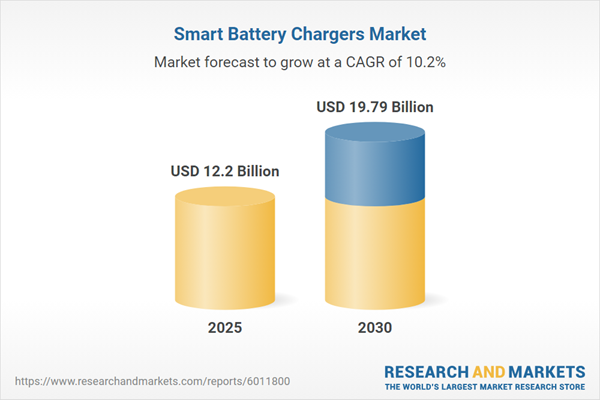Speak directly to the analyst to clarify any post sales queries you may have.
Smart battery chargers are quickly becoming a pivotal asset for organizations aiming to strengthen energy reliability, enable sustainable operations, and support technology-driven transformation strategies in an increasingly complex business landscape.
Market Snapshot: Smart Battery Chargers Market Growth and Opportunities
The smart battery chargers market anticipates substantial expansion, with revenue projected to grow from USD 11.02 billion in 2024 to USD 12.20 billion in 2025 and reach USD 24.51 billion by 2032. This growth, at a compound annual growth rate (CAGR) of 10.50%, is driven by increased investments across automotive, industrial, consumer electronics, and telecommunications industries. As businesses prioritize electrification and advanced charging infrastructure, both policy shifts and rapid technology development are redefining industry focus. Integrated charging solutions are now instrumental in supporting operational adaptability, bolstering business continuity, and advancing long-term energy initiatives across sectors.
Scope & Segmentation: Smart Battery Chargers Market
This analysis delivers practical insights for executives seeking to refine procurement decisions, optimize investment strategies, and enhance scalable energy management. The segmentation approach identifies the main factors that shape technology choices and regulatory response for a diverse set of operational environments.
- Battery Types: Lead Acid, Lithium Ion, Nickel Cadmium, and Nickel Metal Hydride batteries each bring distinct strengths, matching needs from electric vehicle fleet support to grid backup and stability solutions.
- Charging Technologies: Multistage, Pulse, Rapid, and Trickle charging methods offer varying benefits in improving turnaround times, increasing infrastructure dependability, and maximizing energy efficiency in demanding applications.
- End Users: Automotive manufacturers, consumer electronics suppliers, industrial businesses, and telecom operators utilize these chargers to boost equipment uptime, lengthen asset life, and maintain reliability across distributed operations.
- Output Currents: A broad spectrum from portable device chargers under 5A to high-capacity units above 10A meets the requirements of flexible team deployments or centralized energy backup systems.
- Distribution Channels: Aftermarket providers, direct sales, specialized stores, and e-commerce platforms ensure supply chain agility and regional compliance, helping organizations navigate varied procurement frameworks.
- Applications: Use cases span battery maintenance, powering mobile devices, system backup, and integration into renewable energy projects, supporting both daily operational tasks and critical infrastructure needs.
- Regions: Coverage includes the Americas, Europe, Middle East, Africa, and Asia-Pacific, with each region exhibiting different speeds of infrastructure development, varying technology adoption rates, and distinct regulatory impacts.
- Companies: Key market players such as Panasonic Corporation, Robert Bosch GmbH, Stanley Black & Decker, Schneider Electric SE, CTEK Sweden AB, NOCO Company LLC, Clore Automotive Inc., Delta-Q Technologies, EnerSys Inc., and Victron Energy B.V. focus on advancing product design, energy integration, and compliance standards.
Key Takeaways: Strategic Insights for Decision-Makers
- Implementing smart battery chargers extends the useful life of equipment and streamlines operational processes, aligning with broad electrification and energy efficiency efforts.
- Integrating Internet of Things systems and real-time analytics enhances visibility into charging infrastructure, supporting performance monitoring and proactive maintenance for higher uptime.
- Adopting modular charger architectures allows enterprises to quickly scale or adapt energy systems in response to shifting operations or risk profiles.
- Compatibility with multiple battery chemistries builds supply chain flexibility and enables rapid response to technology trends or potential disruptions.
- Differences in infrastructure investment and regulatory practices between regions highlight the necessity of market-specific compliance and tailored approaches for successful entry.
- Strengthening partnerships between manufacturers and system integrators increases interoperability and ensures readiness for upcoming changes in energy utilization.
Tariff Impact: Supply Chain and Pricing Shifts
New tariffs on charging components imported into the United States prompt businesses to reassess supplier relationships and sourcing strategies. Organizations are shifting to more agile procurement and refining technical specifications to manage cost competitiveness and maintain reliable access to crucial components as trade conditions evolve.
Methodology & Data Sources
This report's findings are informed by industry expert interviews, in-depth literature reviews, regulatory evaluations, and carefully selected third-party white papers. Scenario modeling and cross-referencing of data help deliver insights that guide both strategic direction and operational planning for organizations.
Why This Report Matters
- Supports more resilient procurement and investment decision-making as the market landscape and regulatory environment change for smart battery chargers.
- Delivers targeted segmentation to reveal new growth opportunities, enhance supplier risk management, and strengthen compliance workflows across business functions.
- Equips leadership teams to anticipate industry developments and align business strategies based on relevant and timely market intelligence.
Conclusion
With these insights, organizations can design robust and scalable energy management strategies, positioning themselves for enhanced stability and readiness as energy systems and digital technologies transform.
Additional Product Information:
- Purchase of this report includes 1 year online access with quarterly updates.
- This report can be updated on request. Please contact our Customer Experience team using the Ask a Question widget on our website.
Table of Contents
3. Executive Summary
4. Market Overview
7. Cumulative Impact of Artificial Intelligence 2025
Companies Mentioned
The companies profiled in this Smart Battery Chargers market report include:- Panasonic Corporation
- Robert Bosch GmbH
- Stanley Black & Decker, Inc.
- Schneider Electric SE
- CTEK Sweden AB
- NOCO Company LLC
- Clore Automotive, Inc.
- Delta-Q Technologies Corporation
- EnerSys, Inc.
- Victron Energy B.V.
Table Information
| Report Attribute | Details |
|---|---|
| No. of Pages | 189 |
| Published | October 2025 |
| Forecast Period | 2025 - 2032 |
| Estimated Market Value ( USD | $ 12.2 Billion |
| Forecasted Market Value ( USD | $ 24.51 Billion |
| Compound Annual Growth Rate | 10.5% |
| Regions Covered | Global |
| No. of Companies Mentioned | 11 |









